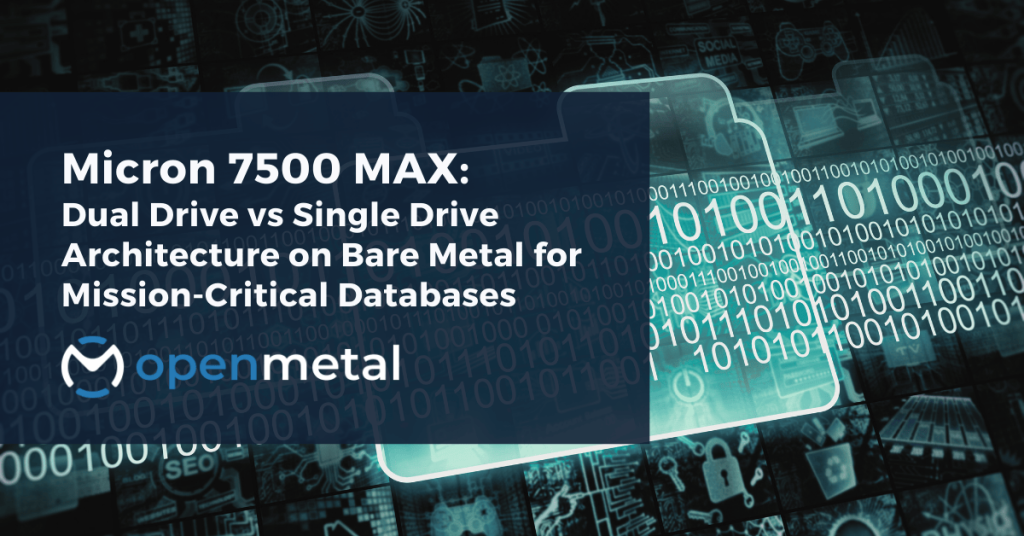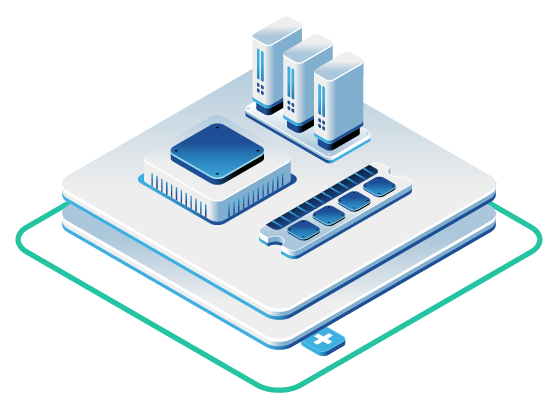
Want to customize your bare metal?
The OpenMetal team is standing by to assist you with scoping out a fixed-cost model based infrastructure plan to fit your needs, budgets and timelines.
When architecting enterprise database infrastructure, storage configuration decisions can make or break your application’s performance profile. While cloud environments abstract away much of the underlying hardware complexity, bare metal deployments give you direct control over NVMe drive selection and configuration—a capability that becomes transformative for database workloads.
The question facing many infrastructure teams today: Should you deploy two smaller, high-endurance NVMe drives (like dual 3.2TB Micron 7500 MAX SSDs) or opt for a single larger drive with equivalent capacity?
This article explores the use case of mission-critical databases running on bare metal servers, where the dual-drive approach delivers measurable advantages in performance, endurance, and operational resilience.
The Bare Metal Advantage: Direct Hardware Access
Before diving into drive configurations, it’s worth understanding why bare metal infrastructure fundamentally changes the storage equation. Unlike virtualized environments where hypervisors introduce latency and abstract hardware capabilities, bare metal servers expose the full potential of your NVMe SSDs.
On bare metal platforms like OpenMetal’s XLv4 and XXLv4 servers, your database applications communicate directly with the NVMe controllers. This direct access eliminates virtualization overhead, reduces tail latency, and allows for hardware-level optimizations that simply aren’t possible in traditional cloud environments. When you’re dealing with microsecond-sensitive OLTP workloads, this difference becomes critical.
Workload Separation: The Foundation of Performance
Database systems generate distinctly different I/O patterns across their components. Transaction logs (PostgreSQL’s WAL, MySQL’s redo logs, Oracle’s redo logs) consist primarily of sequential writes, while data files and indexes involve a mix of random reads and writes during normal operations.
A dual-drive configuration allows you to separate these workloads at the hardware level. By dedicating one Micron 7500 MAX drive to transaction logs and another to database files, you eliminate I/O contention that can create performance bottlenecks. This separation becomes particularly valuable during maintenance operations like checkpoints, compactions, or index rebuilds, where both subsystems would otherwise compete for the same storage resources.
Consider a PostgreSQL deployment handling high-frequency trading data. During market hours, the system processes thousands of transactions per second while simultaneously serving real-time queries. With workload separation, checkpoint operations on the data drive don’t interfere with the continuous WAL writes required for transaction durability.
Parallel I/O Paths: Multiplying Throughput
Single large drives, regardless of their individual performance capabilities, create a throughput ceiling. Two 3.2TB Micron 7500 MAX drives operating in parallel can theoretically deliver twice the IOPS and bandwidth compared to a single 6.4TB drive of the same model family.
This parallel I/O advantage extends beyond raw throughput numbers. During peak load periods, having multiple NVMe controllers and PCIe lanes distributes the workload more evenly across your system’s I/O subsystem. The result is more consistent performance with reduced queue depths and lower latency variance—critical factors for maintaining SLA compliance in enterprise environments.
Endurance Engineering: Optimizing for Write-Heavy Workloads
The Micron 7500 MAX series targets write-intensive enterprise applications with impressive endurance ratings measured in Drive Writes Per Day (DWPD). However, endurance isn’t just about total capacity—it’s about matching drive characteristics to specific workload patterns.
Transaction logs exhibit predictable, sequential write patterns that align perfectly with how NAND flash memory performs best. By dedicating one drive specifically to this workload, you maximize the useful life of both drives. The log drive handles the constant sequential writes it’s designed for, while the data drive manages the mixed workload of reads, writes, and maintenance operations without the additional wear from log activity.
This specialization can extend drive life significantly compared to a single drive handling both workloads. In environments where storage replacement requires maintenance windows and potential service disruptions, this longevity advantage translates directly to reduced operational overhead.
Failure Handling and Recovery Flexibility
Enterprise systems must be designed for component failure, and storage is no exception. Dual-drive configurations provide more granular failure handling and recovery options compared to single-drive deployments.
If the transaction log drive fails, your database can potentially continue operating in a degraded mode while you replace the failed component. Similarly, if the data drive encounters issues, having transaction logs on a separate device can accelerate recovery procedures. This separation also enables more sophisticated backup strategies, such as streaming WAL archives from the dedicated log drive while taking filesystem-level snapshots of the data drive.
OpenMetal’s XXLv4 servers, with their extensive NVMe bays and high-availability design, are particularly well-suited for these resilient configurations. When deployed as bare metal it means you can implement custom monitoring and failover procedures that respond to hardware-level events rather than relying solely on application-level detection.
Hardware-Level Tuning and Optimization
Bare metal deployments unlock tuning capabilities that remain hidden in virtualized environments. With dual drives, you can optimize each device’s configuration for its specific workload. This might include:
- Different over-provisioning levels based on write patterns
- Tailored garbage collection schedules that align with application maintenance windows
- Queue depth optimization for sequential vs. random workloads
- Power management settings that balance performance with thermal considerations
These optimizations, while technical, can yield measurable improvements in both performance and operational efficiency. The ability to tune at this level represents a key advantage of bare metal infrastructure for performance-critical applications.
Implementation Example: Potential Financial Services Scenario
Consider a hypothetical regional bank evaluating PostgreSQL deployment on OpenMetal’s XXLv4 bare metal servers with dual 3.2TB Micron 7500 MAX SSDs. In this scenario, one drive would be dedicated exclusively to WAL files, while the second would handle the primary database files and indexes.
Such a configuration could potentially deliver several advantages: p99 latency during checkpoint operations might decrease by 30-40% compared to single-drive configurations. The system could maintain more consistent performance during intensive month-end processing—a critical requirement for regulatory reporting workflows. The endurance benefits would likely align with typical five-year hardware lifecycles, potentially eliminating concerns about drive replacement during the system’s planned operational life.
This type of deployment demonstrates how bare metal infrastructure combined with thoughtful NVMe configuration can deliver predictable performance for mission-critical applications.
When Single Drives Make Sense
While dual-drive configurations offer compelling advantages, single larger drives aren’t without merit. For read-heavy analytical workloads, development environments, or applications with less stringent latency requirements, a single 6.4TB drive might provide adequate performance with reduced complexity.
Single drives also simplify procurement, reduce the number of potential failure points, and may offer better cost efficiency for capacity-focused workloads. If your database workload is primarily read-oriented or experiences predictable, low-volume write patterns, the additional complexity of dual drives might not justify the benefits.
The Bare Metal Database Advantage
For enterprise databases where performance, predictability, and control matter most, the combination of bare metal infrastructure and dual high-endurance NVMe drives represents a compelling architecture choice. This approach delivers workload separation, parallel I/O capabilities, enhanced endurance, and operational flexibility that single-drive configurations simply cannot match.
OpenMetal’s XLv4 and XXLv4 platforms provide the foundation for these optimized deployments, offering direct hardware access and the flexibility to configure storage systems that align with your specific application requirements. When you combine this infrastructure with proven drives like the Micron 7500 MAX series, you create a database platform capable of handling the most demanding enterprise workloads with confidence and consistency.
The investment in dual-drive architecture pays dividends in reduced latency, improved reliability, and operational predictability—benefits that become increasingly valuable as your applications scale and your business depends more heavily on consistent database performance.
Ready to optimize your database infrastructure with bare metal performance? OpenMetal’s solutions engineering team can help you design the ideal storage configuration for your specific workloads. Whether you’re evaluating dual NVMe setups for OLTP systems or need guidance on drive selection for your enterprise applications, our experts will work with you to ensure your infrastructure delivers the performance and reliability your business demands.
Works Cited
- Micron Technology. “Micron 7500 NVMe SSD.” Micron Products, www.micron.com/products/ssd/7500. Accessed 26 Aug. 2025.
- MySQL Documentation Team. “The InnoDB Redo Log.” MySQL 8.0 Reference Manual, Oracle Corporation, dev.mysql.com/doc/refman/8.0/en/innodb-redo-log.html. Accessed 26 Aug. 2025.
- Oracle Corporation. “Managing Redo Log Files.” Oracle Database Administrator’s Guide, Oracle, docs.oracle.com/en/database/oracle/oracle-database/19/admin/managing-redo-log-files.html. Accessed 26 Aug. 2025.
- PostgreSQL Global Development Group. “Write-Ahead Logging (WAL).” PostgreSQL Documentation, www.postgresql.org/docs/current/wal-intro.html. Accessed 26 Aug. 2025.


































